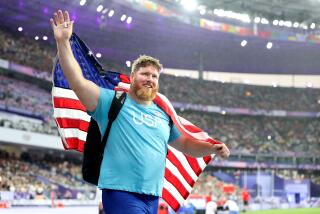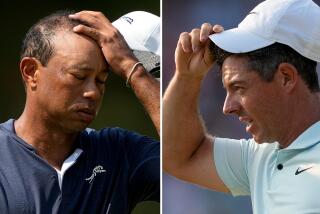Line between success and failure on greens gets blurry with age
Reporting from La Jolla — Stand around the putting green at a PGA Tour event.
Look and listen. The players, who know that averaging one additional stroke a round can cost them millions of dollars over a season, are trying to give themselves every advantage on the greens. They try long putters so tall they practically tickle the golfer’s chin, belly putters, mallet-headed putters and blades, hoping to translate their strokes into the definition of success:
A made putt.
And as golfers age, that challenge can become even more difficult.
Even though it’s natural for players to lose driving distance as they get older, it is putting, which requires less physical power and more mental certainty, that can cause players real problems.
Many golfers go to extreme measures as their putting strokes deteriorate. Near the end of his Hall of Fame career, Sam Snead would straddle the line of his putt and use a stroke that resembled a croquet shot.
Golf eventually outlawed that stroke.
David Kirschen, an optometrist with an expertise in sports and a member of the faculty at UCLA, said that what many golfers don’t understand is how important vision is to putting well. And vision tends to worsen with age.
Kirschen listed acuity — how sharply one sees detail at a distance — as the first component in helping a putter. He also said depth perception and focus matter.
“Can I pick a flag out of the background? Can I see two different shades of green, can I pick up that texture?” Kirschen said. “And then there’s stereo vision. The way your two eyes work together is critical in your ability to read a green. Where it’s sloping, breaking left to right, depth to where the cup is.”
Phil Mickelson, 41, said he isn’t conceding any putting vagaries to age. He tried switching to a belly putter but has put that club away and gone back to a traditional blade-style putter.
“No matter what method you use, you still have to see the line and match it up with the proper speed,” Mickelson said. “For me, I was looking for a shortcut with the belly putter.”
He ranked 108th on the tour in putting last season, down from the 40s three and four years ago.
Matt Kuchar, 33, said he thinks it might be easier to be a great putter as a youngster.
“In your teenaged years you don’t have any fear,” Kuchar said. “The more you play and you have that 10-footer go five feet past the hole, it’s something, in your head, where you get more tentative, you think more about the stroke. You have the thoughts: ‘I have to make this putt.’ ”
Ted Norby, director of instruction for the National University Golf Academy in Carlsbad, agreed that it’s more mind than matter.
“As we get older,” he said, “more negative things have happened to us. As we stand over a four-foot putt, the brain starts remembering the 50 times we’ve missed the four-foot putt. The kid doesn’t think that.”
Mark Sweeney, chief executive of AimPoint Golf, which specializes in the science of putting technology, said he thinks that 95% of golfers rely on their vision to read the greens.
“And that’s the worst sense you can use,” he said. “Your vision starts to degrade dramatically by the time you’re 40.
“We teach that putting should be 90% feel,” said Sweeney, who has worked with Padraig Harrington, J.B. Holmes and Stacy Lewis, who won the Kraft Nabisco Championship in Rancho Mirage last year.
“You need to use your other senses. Get a feel for the tilt, the slope, because what you see with your eyes can be an optical illusion. The biggest problem I see is that golfers pick the wrong target to aim at when they putt.”
Ben Crane, who led after two rounds of the Humana Challenge at La Quinta last weekend, said he concentrated on putting in the off-season.
“We looked at my setup,” he said. “We looked at some of my old footage. I’m just trying now to do what I did then. It sounds crazy simple, but that’s what we worked on, creating more consistency and starting my ball down the intended line.”
Norby said there probably are 100,000 variations of putters on the market. “And I know it seems as if some of these guys have tried them all,” he said.
Norby pointed out that when Jack Nicklaus won his final Masters in 1986, “he was using a putter with a head that was four times bigger than anything we’d seen.”
Robert Garrigus, 34, who finished second in the Humana Challenge, switched from a very short putter to a belly putter this season on the advice of his coach, Jim Ahern.
“I would never in a million years have been like, ‘Oh, I think I need to go to a belly putter,’ ” said Garrigus, who conceded that the belly putter can seem like the “old man” putter. “He took it out to the putting green and he’s like, ‘Hey, try this for a little bit and don’t say anything, just putt with it.’
“And I started rolling it. I started getting confident with it, and about five or six days before I came out here, I found the perfect grip for my putting stroke, and it took all the tension out of it. Man, I tell you what, I haven’t rolled it this good in quite a long time.
“I’m just very, very excited about the year.”
twitter.com/mepucin
More to Read
Go beyond the scoreboard
Get the latest on L.A.'s teams in the daily Sports Report newsletter.
You may occasionally receive promotional content from the Los Angeles Times.










